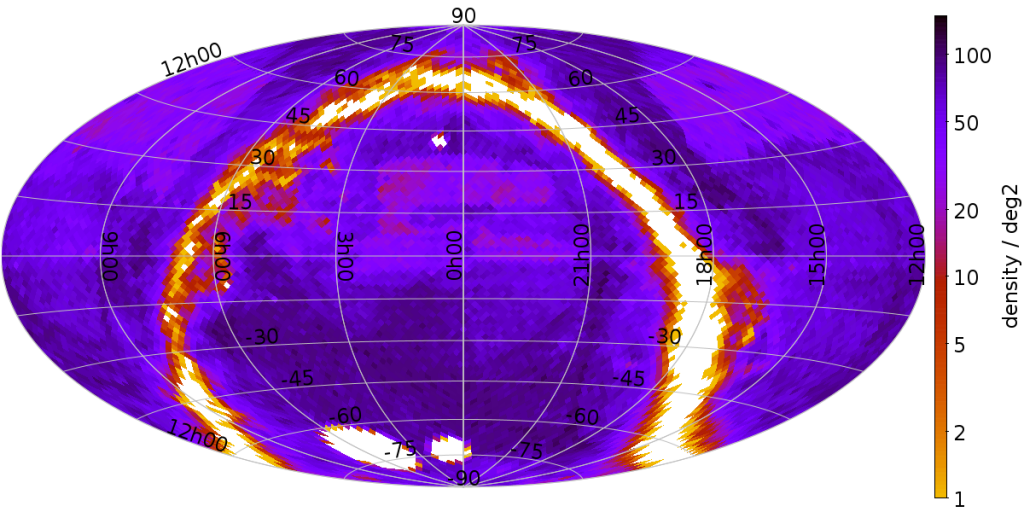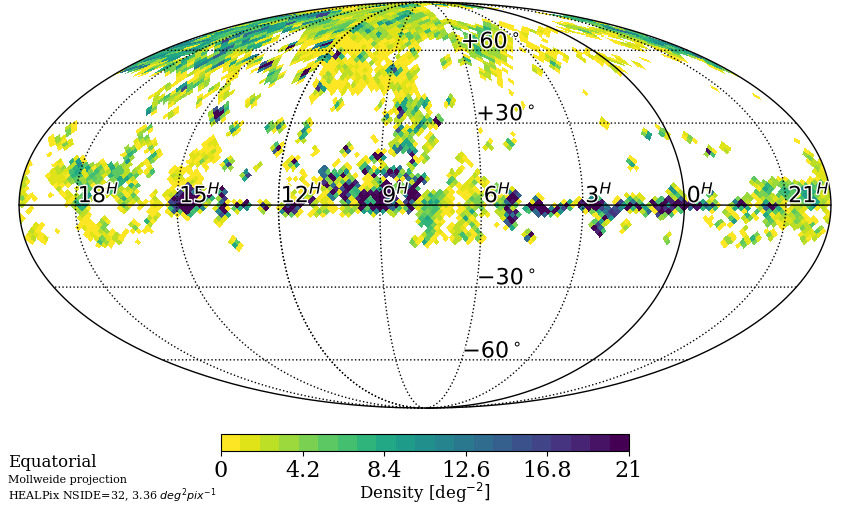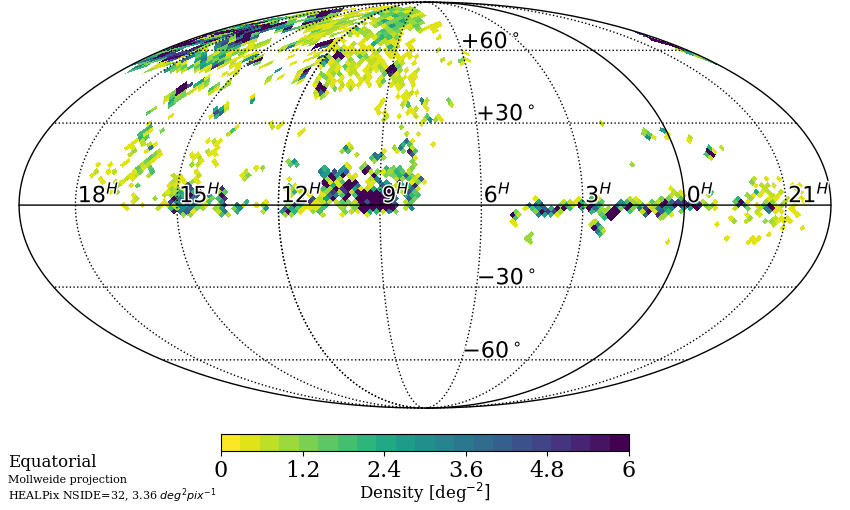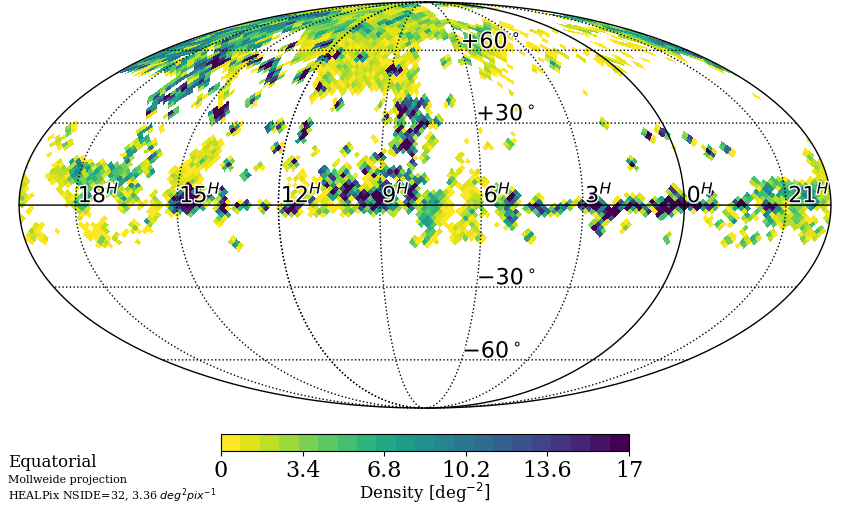- aSummary
- Gaia-unWISE AGN survey
- Bright Low-Redshift Galaxy Survey
- BHM Carton for FPS Commissioning
- Observational goals and requirements
- Target selection and survey implementation
- Targeting generations used in early FPS operations
- Targeting generation used during SDSS-V plate operations
- BHM-centric open fiber programs
- Spectroscopic data released in DR19
aSummary
The BHM project has a number of ancillary spectroscopic programs, which provide scientifically interesting targets when BOSS fibers are not assigned to core science projects. These have the goal of obtaining redshifts and classifications for candidate QSOs and bright galaxies selected via wide-area optical/IR surveys. These supplementary programs do not affect the overall SDSS-V MOS survey plan (allocation of exposure resources across the sky).
Gaia-unWISE AGN survey

This BHM-led program collects BOSS spectroscopy for a large sample of candidate QSOs. We downselect targets suitable for SDSS-V spectroscopy from the parent sample presented by Shu et al. (2019), who used applied a machine-learning approach to a combination of the Gaia DR2 and unWISE catalogues. The Gaia-unWISE AGN targets are distributed across almost the entire sky (except for the innermost Galactic plane and regions around the Magellanic Clouds), and so are well matched to the SDSS-V all-sky survey strategy. This is primarily a discovery program, and so we have excluded AGN targets having existing good quality optical spectroscopy in earlier SDSS iterations.
Bright Low-Redshift Galaxy Survey
This program seeks to measure redshifts and provide classifications for a sample of optically bright, low-redshift, morphologically resolved galaxies, selected from legacysurvey.org/dr8 optical/IR catalogues. This program is primarily intended as a filler, with no expectation of a high degree of spectroscopic completeness.
BHM Carton for FPS Commissioning
In order to support FPS commissioning tests, we defined a carton (manual_bhm_spiders_comm) of X-ray selected targets having known redshifts. These targets were drawn from the eFEDS/SDSS-V sample presented by Aydar, et al (2025). This carton was used to check the ability of the whole SDSS-V system (telescope, FPS, spectrograph and data reduction pipelines) to collect reliable redshifts for SPIDERS-like targets. This carton is not part of any targeting generation because it was never used within a robostrategy run.
Observational goals and requirements
The SDSS-V/BHM Ancillary projects seek to gather spectroscopic redshifts and classifications for large samples of candidate QSOs and galaxies.
These samples generally have only moderate surface density on the sky, and so benefit most from the widest area components of the SDSS-V survey.
Target selection and survey implementation
Further details of the algorithms and criteria used to select BHM ancillary target cartons are provided via the links below.
Targeting generations used in early FPS operations
The ‘v0.5.epsilon-7-core-0’, ‘v0.5.2’, ‘v0.5.3’ and ‘v0.5.5’ targeting generations were used during initial SDSS-V/FPS operations (2022-2023). These generations are identical from the point of view of BHM Ancillary program targeting.
Below is a list of BHM Ancillary cartons that were considered (the carton names link to detailed descriptions):
Targeting generation used during SDSS-V plate operations
The ‘v0.plates’ targeting generation was used during the first year of SDSS-V operations at APO when the old plug plate system was still in place. We included early versions of the Gaia/unWISE AGN cartons during this phase.
Below is a list of BHM Ancillary cartons that were considered (the carton names link to detailed descriptions):
BHM-centric open fiber programs
A subset of the SDSS-V Open Fiber Program focus on BOSS (re-)observations of optical/IR/X-ray selected QSOs/AGN, and so have strong overlap with BHM’s core science themes. The carton names for these six open fiber programs are listed below.
openfibertargets_nov2020_11: All QSOs/AGN, Quasars Second Epochs for SDSS-I/II Quasars observed only onceopenfibertargets_nov2020_18: All QSOs/AGN, Hard X-ray Sources; 10,000 hard-band selected X-ray sources (complementing the soft X-ray selection from eROSITA in SPIDERS)openfibertargets_nov2020_26: All QSOs/AGN, Quasar Winds; long-term spectroscopic monitoring of quasar winds through additional epochs on previously well-observed BAL quasarsopenfibertargets_nov2020_27: All QSOs/AGN, All Bright Quasars; All QSO candidates with G<20, based on WISE colors and optical informationopenfibertargets_nov2020_30: All QSOs/AGN, JWST North Ecliptic Pole Time Domain regionopenfibertargets_nov2020_33: All QSOs/AGN, Variability-Selected AGN and Blazars; Confirmation and Characterization of Variability-selected AGN, QSOs, and Blazars
The Open Fiber programs were not used during the SDSS-V plate program.
Spectroscopic data released in DR19



The number of BHM Ancillary and BHM-centric open fiber program spectra in DR19 are given in the table below.
| (First)Carton name | “daily” coadd spectra | “epoch” coadd spectra | “allepoch” coadd spectra | Unique targets |
|---|---|---|---|---|
| bhm_gua_bright | 26773 | 23735 | 14951 | 15307 |
| bhm_gua_dark | 22897 | 18259 | 12178 | 12723 |
| bhm_colr_galaxies_lsdr8 | 8812 | 7757 | 6223 | 6328 |
| openfibertargets_nov2020_27 | 4373 | 4161 | 2809 | 3899 |
| openfibertargets_nov2020_33 | 2018 | 1999 | 1518 | 1875 |
| manual_bhm_spiders_comm | 1420 | 355 | 291 | 355 |
| openfibertargets_nov2020_18 | 799 | 777 | 361 | 717 |
| openfibertargets_nov2020_11 | 624 | 604 | 58 | 596 |
| openfibertargets_nov2020_26 | 16 | 16 | 8 | 16 |
Back to Black Hole Mapper Science Programs
